外研版英语八年级下册知识点Module-1—5
外研版英语八年级下单元Module 1 知识点+单元卷+思维导图
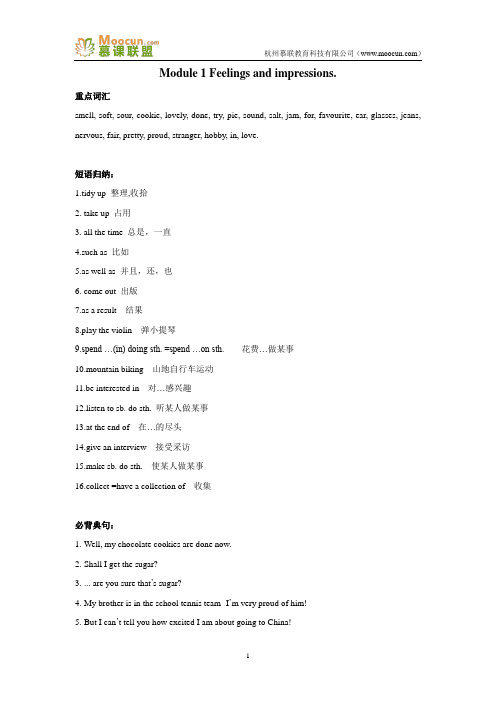
Module 1 Feelings and impressions.重点词汇smell, soft, sour, cookie, lovely, done, try, pie, sound, salt, jam, for, favourite, ear, glasses, jeans, nervous, fair, pretty, proud, stranger, hobby, in, love.短语归纳:1.tidy up 整理,收拾2. take up 占用3. all the time 总是,一直4.such as 比如5.as well as 并且,还,也6. come out 出版7.as a result 结果8.play the violin 弹小提琴9.spend …(in) doing sth. =spend …on sth. 花费…做某事10.mountain biking 山地自行车运动11.be interested in 对…感兴趣12.listen to sb. do sth. 听某人做某事13.at the end of 在…的尽头14.give an interview 接受采访15.make sb. do sth. 使某人做某事16.collect =have a collection of 收集必背典句:1.Well, my chocolate cookies are done now.2.Shall I get the sugar?3.... are you sure that’s sugar?4.My brother is in the school tennis team- I’m very proud of him!5.But I can’t tell you how excited I am about going to China!语法知识:表示感觉和知觉的系动词也称感官系动词1. 五个表示感觉和知觉的系动词与眼、耳、口、鼻、手相关系。
Module 1 Unit 1 知识点详解-外研版八年级下册英语

外研版英语八(下)Module 1 Feelings and impressions 知识点详解Unit 1It smells delicious.Unit 1 It smells delicious.★(A3).【知识点再现】What a delicious smell! 多香的味道啊!【知识点1】本句是一个感叹句。
感叹句通常由what或how引导,表示惊讶、赞美、喜悦、愤怒等感情。
what通常修饰名词,how通常修饰形容词或副词。
感叹句的结构如下:①“What + a/an+形容词+可数名词单数形式(+主语+谓语)!”What a useful book! 多么有用的一本书啊!What a clever boy! 多么聪明的男孩!What an old tree it is! 多么古老的一棵树啊!What a beautiful flower! 多么漂亮的一朵花啊!②“What+形容词+可数名词复数/不可数名词(+主语+谓语)!”What good children they are!他们是多么好的孩子啊!What beautiful flowers they are! 他们是多么漂亮的花啊!What delicious food it is! 它是多么美味的食物啊!What heavy snow it is! 它是多么大的雪啊!③“How+形容词或副词(+主语+谓语)!”How lovely the baby is! 婴儿多么可爱啊!How fast he is running! 他跑得多么快啊!【拓展】感叹句在表示激动、强烈的感情时,口语中常常采用省略的形式,即后面的主语和谓语往往省略。
如:What a fine day! 多么晴朗的天气啊!How wonderful! 精彩极了!★(A3).【知识点再现】Y our pizza looks so nice. 你的比萨饼看起来如此的好。
【知识点2】本句是主系表结构,句中look是感官系动词,意为“看上去;看起来”,后面常接形容词或介词短语作表语。
八年级英语下册 Module 5 Problems知识详解 外研版

八年级英语下册 Module 5 Problems知识详解外研版【同步教育信息】一. 本周教学内容:Module 5 Problems二. 重点内容:If引导的条件状语从句三. 具体内容:Module 5 Problems(一)语法详解条件状语从句引导条件状语从句最常用的连词是if,由 if引导的条件状语从句表示我们不知目前的实际情况如何,但却只要某种条件成立,则必然有预期的结果。
If从句用现在式动词,主句则要用现在式的助动词加动词原形动词。
If...+现在时动词……,主语+⎪⎪⎪⎩⎪⎪⎪⎨⎧maycanshallshouldwill+原形动词本模块主要学习if条件句主句用将来时,从句用一般现在时,简称“主将从现”如:If you ask him,he will help you. 如果你请他帮忙,他会帮你的。
If you fail in the exam,you will let him down. 如果你考试不及格,你会让他失望的。
那么,除了if之外,是否还有其他连词也可以引导条件状语从句呢?回答是肯定的,不仅有,还有很多。
这些词由于出现的频率较小,且用法较复杂一些,所以不如if为大家所熟知罢了。
unless, on condition(that),supposing,provided等词引导的条件状语从句,主从句条件关系分明,结构清晰,但有些句子,虽没有含条件关系的连词,却也隐含着条件关系,这些句子常用一些词,如:but for,without等引出一个介词结构来表示条件,条件常常是虚拟的,或与事实相反的假设。
(二)知识点详解1. Writing a problem page for a magazine.为杂志写一份问题专栏。
辨析:problem 与 question的区别二者都有“问题”的意思,但用法略有不同。
problem 通常指等待解决或决定的问题,尤其比较困难的问题。
例如:It is a problem how to make both ends meet. 如何使收支平衡,那是个问题。
外研版英语八年级下册module 1重点知识归纳
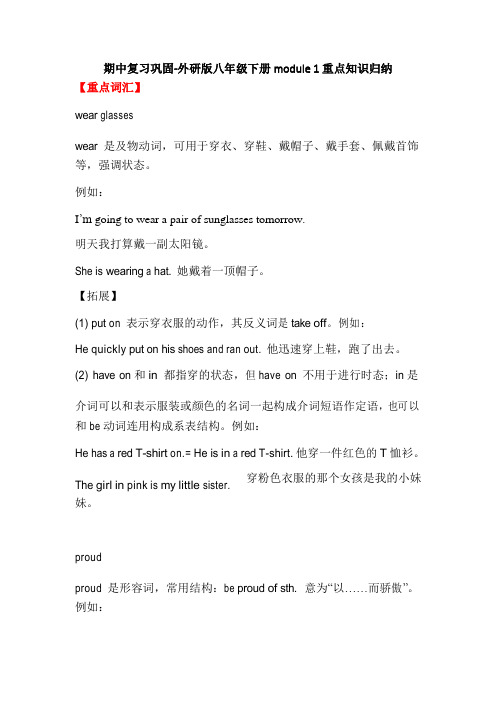
期中复习巩固-外研版八年级下册module1重点知识归纳【重点词汇】wear glasseswear是及物动词,可用于穿衣、穿鞋、戴帽子、戴手套、佩戴首饰等,强调状态。
例如:I’m going to wear a pair of sunglasses tomorrow.明天我打算戴一副太阳镜。
She is wearing a hat.她戴着一顶帽子。
【拓展】(1)put on表示穿衣服的动作,其反义词是take off。
例如:He quickly put on his shoes and ran out.他迅速穿上鞋,跑了出去。
(2)have on和in 都指穿的状态,但have on不用于进行时态;in是介词可以和表示服装或颜色的名词一起构成介词短语作定语,也可以和be动词连用构成系表结构。
例如:He has a red T-shirt on.=He is in a red T-shirt.他穿一件红色的T恤衫。
穿粉色衣服的那个女孩是我的小妹The girl in pink is my little sister.妹。
proudproud是形容词,常用结构:be proud of sth.意为“以……而骄傲”。
例如:I am very proud of being a Chinese.作为一名中国人我很自豪。
be proud to do sth意为“为做某事而骄傲”。
例如:We are proud to be a league member.我们为成为团员而骄傲。
【拓展】pride是名词,意为“骄傲,自豪”。
常用的结构:take pride in sth.意为“为某事骄傲”。
例如:They take great pride in her daughter who is now a famous scientist.他们为成为科学家的女儿而感到自豪。
He is the pride of our city.他是我们城市的骄傲。
外研社八年级下册英语Module 1------2课文及知识点
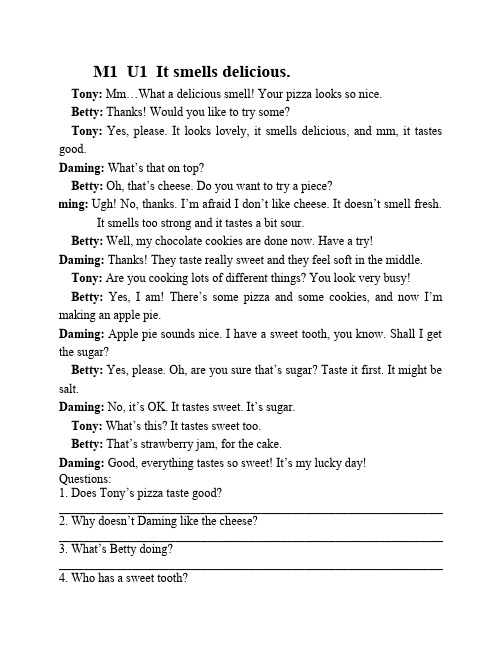
M1 U1 It smells delicious.Tony: Mm…What a delicious smell! Your pizza looks so nice.Betty: Thanks! Would you like to try some?Tony: Yes, please. It looks lovely, it smells delicious, and mm, it tastesgood.Daming: What’s that on top?Betty: Oh, that’s cheese. Do you want to try a piece?Daming: Ugh! No, thanks. I’m afraid I don’t like cheese. It doesn’t smell fresh.It smells too strong and it tastes a bit sour.Betty: Well, my chocolate cookies are done now. Have a try!Daming: Thanks! They taste really sweet and they feel soft in the middle.Tony: Are you cooking lots of different things? You look very busy!Betty:Yes, I am! There’s some pizza and some cookies, and now I’mmaking an apple pie.Daming: Apple pie sounds nice. I have a sweet tooth, you know. Shall I getthe sugar?Betty: Yes, please. Oh, are you sure that’s sugar? Taste it first. It might besalt.Daming: No, it’s OK. It tastes sweet. It’s sugar.Tony: What’s this? It tastes sweet too.Betty: That’s strawberry jam, for the cake.Daming: Good, everything tastes so sweet! It’s my lucky day!Questions:1. Does Tony’s pizza taste good?________________________________________________________________________2. Why doesn’t Daming like the cheese?________________________________________________________________________3. What’s Betty doing?________________________________________________________________________4. Who has a sweet tooth?_________________________________________________________________ Unit 2 I feel nervous when I speak Chinese FROM: SallyTO: LinglingSUBJECT: Re : Welcome to ChinaHi Lingling,1. Thanks for your last message, It was great to hear from you, and I can’t wait to meet you.2. I hope you will know me from my photo when I arrive at the airport. I’m quite tall, with short fair hair, and I wear glasses. I’ll wear jeans and a T-shirt for the journey, but I’ll also carry my warm coat. I’ve got your photo – you look very pretty, so I’m sure we’ll find each other!3. Thanks for telling me about your hobbies. You sound just like me! I spenda lot of time playing classical music with my friends at school, but I also like dance music – I love dancing! I enjoy sports as well, especially tennis. My brother is in the school tennis team – I’m very proud of him! He’s good at everything, but I’m not. Sometimes I get bad marks at school, and I feel sad. I should work harder.4. You asked me, “How do you feel about coming to China?” Well, I often feel a bit sad at first when I leave my mum and dad for a few days, and I’m quite shy when I’m with strangers. I feel nervous when I speak Chinese, but I’ll be fine in a few days. I’m always sorry when I don’t know how to do things in the right way, so please help me when I’m with you in China! Oh, I’m afraid of flying. But I can’t tell you how excited I am about going to China!See you next week!Love,SallyQuestions:1. What does Sally look like?________________________________________________________________________ 2. What are Sally’s hobbies?________________________________________________________________________ 3. Does Sally usually get bad marks?________________________________________________________________________ 4. How does Sally feel about coming to China?________________________________________________________________________ 5. How does Sally feel when she is going to China?________________________________________________________________________仔细看这些句子:1,The chocolate cookies smell sweet.,巧克力曲奇饼干闻起来甜甜的。
外研版八年级下册英语 M5 Unit 1 It's time to watch a cartoon

atthefunnystoriesinthem.
Others,likeSupermanandSpiderman,areabout heroes
(4) fight .They(5)
badpeopletoprotecttheworld.
Thesecartoonsarenotjuststories—theyalsotelaecssho(ns6)
7
Workinpairs.Askandanswerthequestions.
1WhatcartoonsdoyoulikereadingorwatchingonTV? —WhatcartoonsdoyoulikewatchingonTV? —IlikewatchingSupermanandTomandJerryonTV.
Module5 Cartoons
Unit1 It'stimetowatchacartoon.
同学们,上一课学习的单词、短语和句型你们都掌握了 吗?现在大家来检验一下,点击下面的音频开始听写吧!
Doyoulikewatchingacartoon? Why?
1
Listeningandvocabulary Answerthequestions. 1Whatkindofcartoonsdoyoulike?
典例 用所给词的适当形式填空 Theywereall_____h_e_r_o_e_s_ (hero) inthefight. [达州改编]
知识点 4 Idon’tthinkweagree.
考点5 否定前移的用法本句属于否定前移。当 I/Wethink/believe/suppose/expect等后接含有 not 的否定从句时,该否定应移至主句,即否定 主句的谓语动词。
Module1重点短语句型 2021-2022学年外研版英语八年级下册

Module 1 Unit1短语:1.在顶部/在上面2. 尝一尝,试一试尝一些尝一片3. 喜欢吃甜食4.有点酸(一点面包)5. 确定,确信6. 恐怕,担心7.好香啊!8. 我的幸运日9.鱼干,干鱼10. 有强烈的味道,味道浓厚11. 变酸,出漏子,不再受欢迎Unit1必背句型1. 好香啊!2.你的比萨看上去不错。
3. 你想尝尝吗?4. 它看上去不错,闻起来很香,好吃。
5.你想尝一片吗?6. 恐怕我不喜欢奶酪。
7.它闻起来不新鲜了。
8. 它闻起来味道太重而且尝起来有点酸。
9.他们尝起来真的很甜而且里面很酥软。
10.苹果派听起来不错。
11. 你知道的,我爱吃甜食。
12. 我给你拿糖吧?13. 所有的东西尝起来都这么甜。
14.干鱼的味道很重。
你在菜里不需要放很多。
15.牛奶经过一夜已经变酸了,所以我们不能喝。
Unit2 短语1.因...而感谢2. 收到某人的来信3.等不及做.../ 迫不及待做...4. 戴眼镜5. 穿牛仔裤6.彼此,互相7. 花...做某事8.也,和,以及(肯定句句末)9. 以...为自豪10.得低/高分,取得不好/好的成绩11.对...的意见;对...的态度12.感觉有点伤心13.起初,开始时14. 过了几天(用提问)15.几天后(用提问) 16. 用正确的方式17.害怕坐飞机18.下周见19.给我发信息,给我发邮件20.要求我帮她做英语作业Unit2句型1.收到你的来信真是太好了。
我真想马上见到你。
2.我希望我到机场的时候,你能通过我的照片认出我。
3.我确信我能找到彼此。
4. 谢谢你告诉我你的爱好。
5.在学校我和朋友们花很多时间演奏古典音乐。
6.我也喜欢运动,尤其是网球。
7.我为他感到自豪。
8.你来中国感觉怎么样?9. 当我离开父母几天的时候,起初我经常觉得有点难过;当我和陌生人在一起的时候,我很害羞。
10.当我讲汉语时我会觉得有点紧张但过几天就好了。
11.当我不知道该如何处理事情时,我总是很抱歉;所以当我去中国和你在一起时,请帮帮我12.要去中国了,你不知道我有多么兴奋!I. 写出下列单词的变化形式1. smell _______ _________ (过去式、过去分词)2. soft ______________(adv)3.love_______________(adj)4. salt______________(adj.)5.proud___________(n.)6. strange _____________(n.)7.hobby _______________(pl.)8. do _______________(adj.)9. feel ____________ (过去式)10. taste ______________(adj.)M1Unit1短语:1.on top 在顶部/在上面2. have a try 尝一尝,试一试try some 尝一些try a piece 尝一片3.have a sweet tooth 喜欢吃甜食4.a bit sour有点酸(a bit of bread一点面包)5. be sure确定,确信( of ... / to do / +从句)6. be afr aid恐怕,担心( of doing/to do/+从句)7.What a delicious smell.好香啊!8. my lucky day 我的幸运日9.dried fish 鱼干,干鱼10. have a strong taste有强烈的味道,味道浓厚11. go sour 变酸,出漏子,不再受欢迎Unit1必背句型1.What a delicious smell ! 好香啊!2.Your pizza looks nice . 你的比萨看上去不错。
外研版2019-2020年八年级英语下册重点短语和重点语法 Module 1 Feelings and expressions(含习题和答案)

Module 1 Feelings and expressions 重点短语:1. look sb. in the eye 正视某人2. look 形容词看上去…3. be afraid that 从句恐怕…be afraid to do sth 害怕做某事be afraid of doing sth 害怕……4. thank (sb ) for doing sth 因某人做某事而感谢thank(sb)for sth 因…感谢某人5. can’t wait to do sth 迫不及待做某事6. spend 时间/金钱(in)doing sth. 某人花时间/金钱做…spend 时间/金钱on sth. 某人在某方面花时间/金钱7. be proud of… 以…为自豪8. be proud to do sth. 为做某事而感到自豪9. be proud that… 为……感到自豪10. hear from/ receive a letter from... 收到......的来信11. each other 互相,彼此12. arrive in/at 到达13. be good at 擅长,善于14. have a try 尝试;试试看15. on top 在上面,处于优势16. in the middle 在中间17. as well 也;还18. in the right way 以正确的方式19. be excited about 对...兴奋20. shake hands 握手21. close to 离......近22. have a sweet to对甜食的爱好23. short fair hair 金黄色的短发24. 正确的方式in the right way25. a lot of/pretty of 大量的26. in the middle 在…中部27. what’s the matter with you?= what’s wrong with you?= what’s the trouble with you?28.worry about 担心be worried of sb/sth 害怕某人或某物29.for a few days 持续今天in a few days 在几天后30.be like 人怎么样(问品格)look like = do(es)like长的怎么样31.get good marks 取得好成绩知识点总结:1.It tastes good... / It looks lovely... / It smells too strong and it tastes a bit sour.感官动词(look, smell, taste, sound, feel…)+ adj.2. What a delicious smell! / How delicious the smell is!感叹句:What a beautiful girl (she is)!形容词+名词(主谓)省略How beautiful the girl is !形容词主谓捷径:去掉主谓后,如果还剩一个单词则选how,剩多个单词选what,至于加不加a/an,看名词是否可数。
新外研版英语八年级下册modul...

新外研版英语八年级下册modul...Module 1 HobbiesUnit 1 Do you collect anything?Warm up by learning about sentence components.Hello, class. A sentence is made up of several parts. The subject comes at the beginning part. The predicative comes after the subject. And the object follows the predictive.Look at the following sentences.I (subject) bought (predicative) a new car (object) for my collection.He (subject) gave (predicative) me (indirect object) an old sports car(direct object). His collection (subject) made (predicative) me(object) very happy(object complement).Listen and check.Turn to page 2, class. Listen and answer the three questions.Now let’s make sentences with each of the word(s) in the box.He likes to collect (up) the empty glasses, dirty plates, waste paper 他喜欢收集空瓶、脏碟、废纸。
The dustmen collect the rubbish once a week. 垃圾工每周运走一次垃圾。
八年级外研版下册Module 5 Cartoons.重点短语积累及知识点讲解
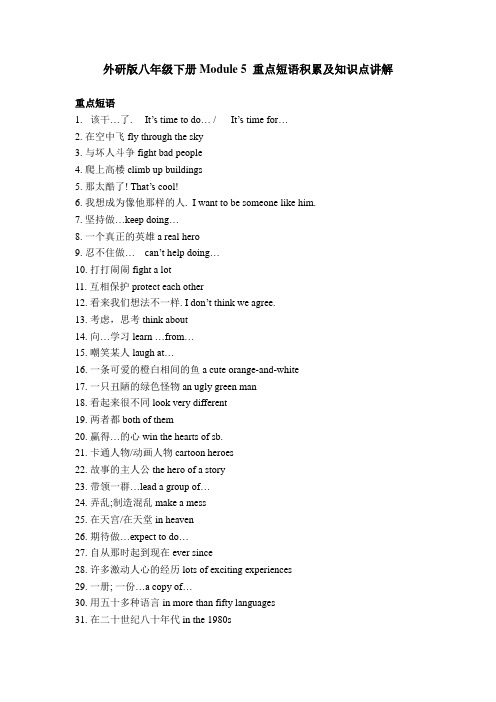
外研版八年级下册Module 5 重点短语积累及知识点讲解重点短语1.该干…了. It’s time to do…/ It’s time for…2. 在空中飞 fly through the sky3. 与坏人斗争 fight bad people4. 爬上高楼 climb up buildings5. 那太酷了! That’s cool!6. 我想成为像他那样的人. I want to be someone like him.7. 坚持做…keep doing…8. 一个真正的英雄a real hero9. 忍不住做… can’t help doing…10. 打打闹闹 fight a lot11. 互相保护protect each other12. 看来我们想法不一样. I don’t think we agree.13. 考虑,思考think about14. 向…学习learn …from…15. 嘲笑某人laugh at…16. 一条可爱的橙白相间的鱼 a cute orange-and-white17. 一只丑陋的绿色怪物an ugly green man18. 看起来很不同look very different19. 两者都both of them20. 赢得…的心win the hearts of sb.21. 卡通人物/动画人物cartoon heroes22. 故事的主人公the hero of a story23. 带领一群…lead a group of…24. 弄乱;制造混乱make a mess25. 在天宫/在天堂in heaven26. 期待做…expect to do…27. 自从那时起到现在ever since28. 许多激动人心的经历lots of exciting experiences29. 一册; 一份…a copy of…30. 用五十多种语言in more than fifty languages31. 在二十世纪八十年代in the 1980s32. 丁丁黑白画册blacck-and-white Tintin books33. 他六十岁生日his sixtieth birthday34. 生活在他自己的私人世界里 live in his own private world35. 现实生活real life36. 发现…很难理解find sth. hard to understand37. 也;和…一样;不仅…而且as well as…38. …和…都…both…and重点句:1.他已经流行了八十多年了》He has been popular for over eighty years.2.丁丁在二十世纪八十年代出现在中国。
外研社八年级英语下册M1---M5模块知识要点及写作范文(精华版)
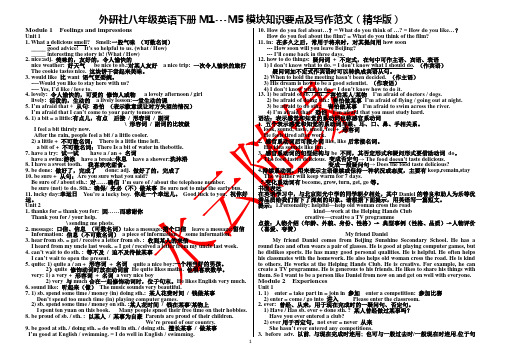
Module 1 Feelings and impressionsUnit 11. What a delicious smell? Smell:一股气味_____ good advice! It’s so helpful to us. (what / How) _____ interesting the story is! (What / How)2. nice:adj. 美味的,友好的,令人愉快的nice weather: 好天气be nice to sb.:The cookie tastes nice. 这块饼干尝起来美味。
3. would like 比want 语气更委婉。
----Would you like to stay here with us?---- Yes, I’d like / love to.4. lovely: 令人愉快的,可爱的修饰人或物lively: 活泼的,生动的 a lively lesson:5. I’m afraid that + 从句: 恐怕6. 1) a bit = a little:有点儿,有点后接/ 形容词\ 形容词I feel a bit thirsty now.After the rain, people feel a bit / a little cooler.2) a little + 不可数名词:a bit of + 不可数名词:7. have a try: 试一试have a / an + 名词have a swim:游泳have a break:休息8. I have a sweet tooth. 我喜欢吃甜食。
9. be done: 做好了,完成了done: adj.10. be sure + 从句:Are you sure what you said?Be sure of / about sth.: 对……确信be sure (not) to do. Sth.: 确保/11. lucky day:幸运日You’re a lucky boy.运。
外研版英语八年级下册Module1模块知识点归纳
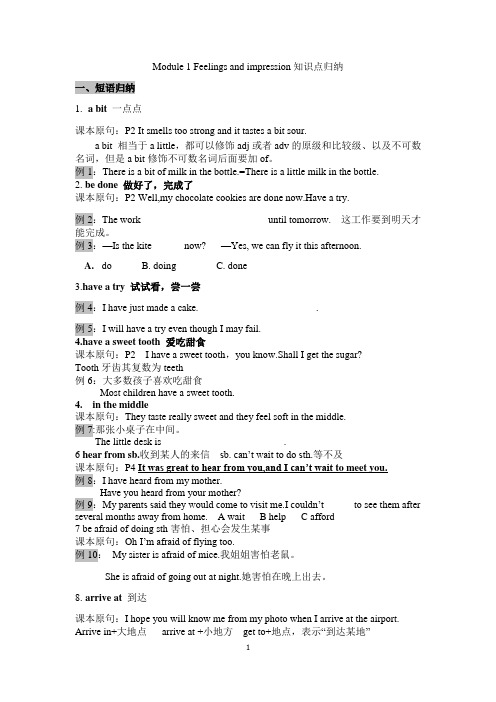
Module 1 Feelings and impression知识点归纳一、短语归纳1. a bit一点点课本原句:P2 It smells too strong and it tastes a bit sour.a bit 相当于a little,都可以修饰adj或者adv的原级和比较级、以及不可数名词,但是a bit修饰不可数名词后面要加of。
例1:There is a bit of milk in the bottle.=There is a little milk in the bottle.2. be done 做好了,完成了课本原句:P2 Well,my chocolate cookies are done now.Have a try.例2:The work _______ _________ ________until tomorrow. 这工作要到明天才能完成。
例3:—Is the kite ______now? —Yes, we can fly it this afternoon.A.doB. doingC. done3.have a try 试试看,尝一尝例4:I have just made a cake. ______ ______ ______.例5:I will have a try even though I may fail.4.have a sweet tooth 爱吃甜食课本原句:P2 I have a sweet tooth,you know.Shall I get the sugar?Tooth牙齿其复数为teeth例6:大多数孩子喜欢吃甜食Most children have a sweet tooth.4.in the middle课本原句:They taste really sweet and they feel soft in the middle.例7:那张小桌子在中间。
外研版英语八年级下册知识点Module-1—5
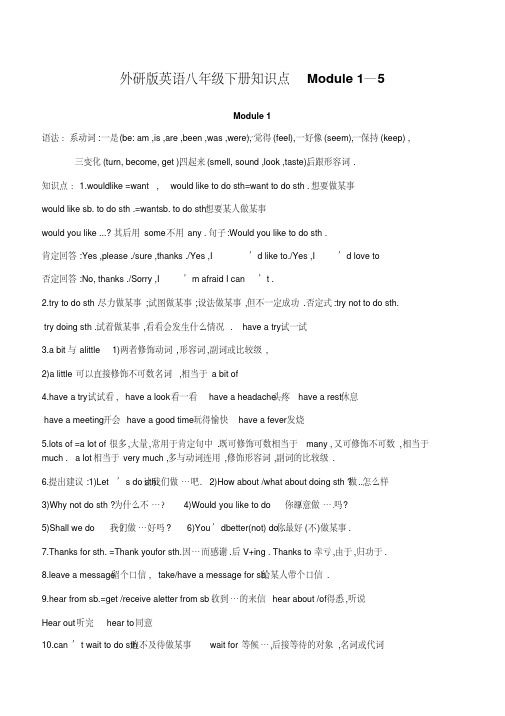
外研版英语八年级下册知识点Module 1—5Module 1语法:系动词:一是(be: am ,is ,are ,been ,was ,were),一觉得(feel),一好像(seem),一保持(keep) ,三变化(turn, become, get ),四起来(smell, sound ,look ,taste),后跟形容词.知识点:1.wouldlike =want , would like to do sth=want to do sth . 想要做某事would like sb. to do sth .=wantsb. to do sth 想要某人做某事would you like ...? 其后用some 不用any . 句子:Would you like to do sth .肯定回答:Yes ,please ./sure ,thanks ./Yes ,I’d like to./Yes ,I’d love to否定回答:No, thanks ./Sorry ,I’m afraid I can’t .2.try to do sth .尽力做某事;试图做某事;设法做某事,但不一定成功.否定式:try not to do sth.try doing sth .试着做某事,看看会发生什么情况. have a try 试一试3.a bit 与alittle 1)两者修饰动词,形容词,副词或比较级,2)a little 可以直接修饰不可数名词,相当于a bit of4.have a try 试试看, have a look 看一看have a headache头疼have a rest 休息have a meeting 开会 have a good time 玩得愉快 have a fever发烧5.lots of =a lot of 很多,大量,常用于肯定句中.既可修饰可数相当于many , 又可修饰不可数,相当于much . a lot 相当于very much ,多与动词连用,修饰形容词,副词的比较级.让我们做…吧. 2)How about /what about doing sth ?做..怎么样6.提出建议:1)Let’s do sth.你愿意做….吗?3)Why not do sth ?为什么不…?4)Would you like to do…?我们做…好吗? 6)You’dbetter(not) do ..你最好(不)做某事.5)Shall we do …?7.Thanks for sth. =Thank youfor sth. 因…而感谢.后V+ing . Thanks to 幸亏,由于,归功于.8.leave a message留个口信, take/have a message for sb.给某人带个口信.9.hear from sb.=get /receive aletter from sb . 收到…的来信 hear about /of 得悉,听说Hear out 听完hear to 同意迫不及待做某事wait for 等候…,后接等待的对象,名词或代词10.can’t wait to do sth .外研版英语八年级下册知识点Module 1—5Module 1语法:系动词:一是(be: am ,is ,are ,been ,was ,were),一觉得(feel),一好像(seem),一保持(keep) ,三变化(turn, become, get ),四起来(smell, sound ,look ,taste),后跟形容词.知识点:1.wouldlike =want , would like to do sth=want to do sth . 想要做某事would like sb. to do sth .=wantsb. to do sth 想要某人做某事would you like ...? 其后用some 不用any . 句子:Would you like to do sth .肯定回答:Yes ,please ./sure ,thanks ./Yes ,I’d like to./Yes ,I’d love to否定回答:No, thanks ./Sorry ,I’m afraid I can’t .2.try to do sth .尽力做某事;试图做某事;设法做某事,但不一定成功.否定式:try not to do sth.try doing sth .试着做某事,看看会发生什么情况. have a try 试一试3.a bit 与alittle 1)两者修饰动词,形容词,副词或比较级,2)a little 可以直接修饰不可数名词,相当于a bit of4.have a try 试试看, have a look 看一看have a headache头疼have a rest 休息have a meeting 开会 have a good time 玩得愉快 have a fever发烧5.lots of =a lot of 很多,大量,常用于肯定句中.既可修饰可数相当于many , 又可修饰不可数,相当于much . a lot 相当于very much ,多与动词连用,修饰形容词,副词的比较级.让我们做…吧. 2)How about /what about doing sth ?做..怎么样6.提出建议:1)Let’s do sth.你愿意做….吗?3)Why not do sth ?为什么不…?4)Would you like to do…?我们做…好吗? 6)You’dbetter(not) do ..你最好(不)做某事.5)Shall we do …?7.Thanks for sth. =Thank youfor sth. 因…而感谢.后V+ing . Thanks to 幸亏,由于,归功于.8.leave a message留个口信, take/have a message for sb.给某人带个口信.9.hear from sb.=get /receive aletter from sb . 收到…的来信 hear about /of 得悉,听说Hear out 听完hear to 同意迫不及待做某事wait for 等候…,后接等待的对象,名词或代词10.can’t wait to do sth .外研版英语八年级下册知识点Module 1—5Module 1语法:系动词:一是(be: am ,is ,are ,been ,was ,were),一觉得(feel),一好像(seem),一保持(keep) ,三变化(turn, become, get ),四起来(smell, sound ,look ,taste),后跟形容词.知识点:1.wouldlike =want , would like to do sth=want to do sth . 想要做某事would like sb. to do sth .=wantsb. to do sth 想要某人做某事would you like ...? 其后用some 不用any . 句子:Would you like to do sth .肯定回答:Yes ,please ./sure ,thanks ./Yes ,I’d like to./Yes ,I’d love to否定回答:No, thanks ./Sorry ,I’m afraid I can’t .2.try to do sth .尽力做某事;试图做某事;设法做某事,但不一定成功.否定式:try not to do sth.try doing sth .试着做某事,看看会发生什么情况. have a try 试一试3.a bit 与alittle 1)两者修饰动词,形容词,副词或比较级,2)a little 可以直接修饰不可数名词,相当于a bit of4.have a try 试试看, have a look 看一看have a headache头疼have a rest 休息have a meeting 开会 have a good time 玩得愉快 have a fever发烧5.lots of =a lot of 很多,大量,常用于肯定句中.既可修饰可数相当于many , 又可修饰不可数,相当于much . a lot 相当于very much ,多与动词连用,修饰形容词,副词的比较级.让我们做…吧. 2)How about /what about doing sth ?做..怎么样6.提出建议:1)Let’s do sth.你愿意做….吗?3)Why not do sth ?为什么不…?4)Would you like to do…?我们做…好吗? 6)You’dbetter(not) do ..你最好(不)做某事.5)Shall we do …?7.Thanks for sth. =Thank youfor sth. 因…而感谢.后V+ing . Thanks to 幸亏,由于,归功于.8.leave a message留个口信, take/have a message for sb.给某人带个口信.9.hear from sb.=get /receive aletter from sb . 收到…的来信 hear about /of 得悉,听说Hear out 听完hear to 同意迫不及待做某事wait for 等候…,后接等待的对象,名词或代词10.can’t wait to do sth .外研版英语八年级下册知识点Module 1—5Module 1语法:系动词:一是(be: am ,is ,are ,been ,was ,were),一觉得(feel),一好像(seem),一保持(keep) ,三变化(turn, become, get ),四起来(smell, sound ,look ,taste),后跟形容词.知识点:1.wouldlike =want , would like to do sth=want to do sth . 想要做某事would like sb. to do sth .=wantsb. to do sth 想要某人做某事would you like ...? 其后用some 不用any . 句子:Would you like to do sth .肯定回答:Yes ,please ./sure ,thanks ./Yes ,I’d like to./Yes ,I’d love to否定回答:No, thanks ./Sorry ,I’m afraid I can’t .2.try to do sth .尽力做某事;试图做某事;设法做某事,但不一定成功.否定式:try not to do sth.try doing sth .试着做某事,看看会发生什么情况. have a try 试一试3.a bit 与alittle 1)两者修饰动词,形容词,副词或比较级,2)a little 可以直接修饰不可数名词,相当于a bit of4.have a try 试试看, have a look 看一看have a headache头疼have a rest 休息have a meeting 开会 have a good time 玩得愉快 have a fever发烧5.lots of =a lot of 很多,大量,常用于肯定句中.既可修饰可数相当于many , 又可修饰不可数,相当于much . a lot 相当于very much ,多与动词连用,修饰形容词,副词的比较级.让我们做…吧. 2)How about /what about doing sth ?做..怎么样6.提出建议:1)Let’s do sth.你愿意做….吗?3)Why not do sth ?为什么不…?4)Would you like to do…?我们做…好吗? 6)You’dbetter(not) do ..你最好(不)做某事.5)Shall we do …?7.Thanks for sth. =Thank youfor sth. 因…而感谢.后V+ing . Thanks to 幸亏,由于,归功于.8.leave a message留个口信, take/have a message for sb.给某人带个口信.9.hear from sb.=get /receive aletter from sb . 收到…的来信 hear about /of 得悉,听说Hear out 听完hear to 同意迫不及待做某事wait for 等候…,后接等待的对象,名词或代词10.can’t wait to do sth .外研版英语八年级下册知识点Module 1—5Module 1语法:系动词:一是(be: am ,is ,are ,been ,was ,were),一觉得(feel),一好像(seem),一保持(keep) ,三变化(turn, become, get ),四起来(smell, sound ,look ,taste),后跟形容词.知识点:1.wouldlike =want , would like to do sth=want to do sth . 想要做某事would like sb. to do sth .=wantsb. to do sth 想要某人做某事would you like ...? 其后用some 不用any . 句子:Would you like to do sth .肯定回答:Yes ,please ./sure ,thanks ./Yes ,I’d like to./Yes ,I’d love to否定回答:No, thanks ./Sorry ,I’m afraid I can’t .2.try to do sth .尽力做某事;试图做某事;设法做某事,但不一定成功.否定式:try not to do sth.try doing sth .试着做某事,看看会发生什么情况. have a try 试一试3.a bit 与alittle 1)两者修饰动词,形容词,副词或比较级,2)a little 可以直接修饰不可数名词,相当于a bit of4.have a try 试试看, have a look 看一看have a headache头疼have a rest 休息have a meeting 开会 have a good time 玩得愉快 have a fever发烧5.lots of =a lot of 很多,大量,常用于肯定句中.既可修饰可数相当于many , 又可修饰不可数,相当于much . a lot 相当于very much ,多与动词连用,修饰形容词,副词的比较级.让我们做…吧. 2)How about /what about doing sth ?做..怎么样6.提出建议:1)Let’s do sth.你愿意做….吗?3)Why not do sth ?为什么不…?4)Would you like to do…?我们做…好吗? 6)You’dbetter(not) do ..你最好(不)做某事.5)Shall we do …?7.Thanks for sth. =Thank youfor sth. 因…而感谢.后V+ing . Thanks to 幸亏,由于,归功于.8.leave a message留个口信, take/have a message for sb.给某人带个口信.9.hear from sb.=get /receive aletter from sb . 收到…的来信 hear about /of 得悉,听说Hear out 听完hear to 同意迫不及待做某事wait for 等候…,后接等待的对象,名词或代词10.can’t wait to do sth .外研版英语八年级下册知识点Module 1—5Module 1语法:系动词:一是(be: am ,is ,are ,been ,was ,were),一觉得(feel),一好像(seem),一保持(keep) ,三变化(turn, become, get ),四起来(smell, sound ,look ,taste),后跟形容词.知识点:1.wouldlike =want , would like to do sth=want to do sth . 想要做某事would like sb. to do sth .=wantsb. to do sth 想要某人做某事would you like ...? 其后用some 不用any . 句子:Would you like to do sth .肯定回答:Yes ,please ./sure ,thanks ./Yes ,I’d like to./Yes ,I’d love to否定回答:No, thanks ./Sorry ,I’m afraid I can’t .2.try to do sth .尽力做某事;试图做某事;设法做某事,但不一定成功.否定式:try not to do sth.try doing sth .试着做某事,看看会发生什么情况. have a try 试一试3.a bit 与alittle 1)两者修饰动词,形容词,副词或比较级,2)a little 可以直接修饰不可数名词,相当于a bit of4.have a try 试试看, have a look 看一看have a headache头疼have a rest 休息have a meeting 开会 have a good time 玩得愉快 have a fever发烧5.lots of =a lot of 很多,大量,常用于肯定句中.既可修饰可数相当于many , 又可修饰不可数,相当于much . a lot 相当于very much ,多与动词连用,修饰形容词,副词的比较级.让我们做…吧. 2)How about /what about doing sth ?做..怎么样6.提出建议:1)Let’s do sth.你愿意做….吗?3)Why not do sth ?为什么不…?4)Would you like to do…?我们做…好吗? 6)You’dbetter(not) do ..你最好(不)做某事.5)Shall we do …?7.Thanks for sth. =Thank youfor sth. 因…而感谢.后V+ing . Thanks to 幸亏,由于,归功于.8.leave a message留个口信, take/have a message for sb.给某人带个口信.9.hear from sb.=get /receive aletter from sb . 收到…的来信 hear about /of 得悉,听说Hear out 听完hear to 同意迫不及待做某事wait for 等候…,后接等待的对象,名词或代词10.can’t wait to do sth .外研版英语八年级下册知识点Module 1—5Module 1语法:系动词:一是(be: am ,is ,are ,been ,was ,were),一觉得(feel),一好像(seem),一保持(keep) ,三变化(turn, become, get ),四起来(smell, sound ,look ,taste),后跟形容词.知识点:1.wouldlike =want , would like to do sth=want to do sth . 想要做某事would like sb. to do sth .=wantsb. to do sth 想要某人做某事would you like ...? 其后用some 不用any . 句子:Would you like to do sth .肯定回答:Yes ,please ./sure ,thanks ./Yes ,I’d like to./Yes ,I’d love to否定回答:No, thanks ./Sorry ,I’m afraid I can’t .2.try to do sth .尽力做某事;试图做某事;设法做某事,但不一定成功.否定式:try not to do sth.try doing sth .试着做某事,看看会发生什么情况. have a try 试一试3.a bit 与alittle 1)两者修饰动词,形容词,副词或比较级,2)a little 可以直接修饰不可数名词,相当于a bit of4.have a try 试试看, have a look 看一看have a headache头疼have a rest 休息have a meeting 开会 have a good time 玩得愉快 have a fever发烧5.lots of =a lot of 很多,大量,常用于肯定句中.既可修饰可数相当于many , 又可修饰不可数,相当于much . a lot 相当于very much ,多与动词连用,修饰形容词,副词的比较级.让我们做…吧. 2)How about /what about doing sth ?做..怎么样6.提出建议:1)Let’s do sth.你愿意做….吗?3)Why not do sth ?为什么不…?4)Would you like to do…?我们做…好吗? 6)You’dbetter(not) do ..你最好(不)做某事.5)Shall we do …?7.Thanks for sth. =Thank youfor sth. 因…而感谢.后V+ing . Thanks to 幸亏,由于,归功于.8.leave a message留个口信, take/have a message for sb.给某人带个口信.9.hear from sb.=get /receive aletter from sb . 收到…的来信 hear about /of 得悉,听说Hear out 听完hear to 同意迫不及待做某事wait for 等候…,后接等待的对象,名词或代词10.can’t wait to do sth .外研版英语八年级下册知识点Module 1—5Module 1语法:系动词:一是(be: am ,is ,are ,been ,was ,were),一觉得(feel),一好像(seem),一保持(keep) ,三变化(turn, become, get ),四起来(smell, sound ,look ,taste),后跟形容词.知识点:1.wouldlike =want , would like to do sth=want to do sth . 想要做某事would like sb. to do sth .=wantsb. to do sth 想要某人做某事would you like ...? 其后用some 不用any . 句子:Would you like to do sth .肯定回答:Yes ,please ./sure ,thanks ./Yes ,I’d like to./Yes ,I’d love to否定回答:No, thanks ./Sorry ,I’m afraid I can’t .2.try to do sth .尽力做某事;试图做某事;设法做某事,但不一定成功.否定式:try not to do sth.try doing sth .试着做某事,看看会发生什么情况. have a try 试一试3.a bit 与alittle 1)两者修饰动词,形容词,副词或比较级,2)a little 可以直接修饰不可数名词,相当于a bit of4.have a try 试试看, have a look 看一看have a headache头疼have a rest 休息have a meeting 开会 have a good time 玩得愉快 have a fever发烧5.lots of =a lot of 很多,大量,常用于肯定句中.既可修饰可数相当于many , 又可修饰不可数,相当于much . a lot 相当于very much ,多与动词连用,修饰形容词,副词的比较级.让我们做…吧. 2)How about /what about doing sth ?做..怎么样6.提出建议:1)Let’s do sth.你愿意做….吗?3)Why not do sth ?为什么不…?4)Would you like to do…?我们做…好吗? 6)You’dbetter(not) do ..你最好(不)做某事.5)Shall we do …?7.Thanks for sth. =Thank youfor sth. 因…而感谢.后V+ing . Thanks to 幸亏,由于,归功于.8.leave a message留个口信, take/have a message for sb.给某人带个口信.9.hear from sb.=get /receive aletter from sb . 收到…的来信 hear about /of 得悉,听说Hear out 听完hear to 同意迫不及待做某事wait for 等候…,后接等待的对象,名词或代词10.can’t wait to do sth .外研版英语八年级下册知识点Module 1—5Module 1语法:系动词:一是(be: am ,is ,are ,been ,was ,were),一觉得(feel),一好像(seem),一保持(keep) ,三变化(turn, become, get ),四起来(smell, sound ,look ,taste),后跟形容词.知识点:1.wouldlike =want , would like to do sth=want to do sth . 想要做某事would like sb. to do sth .=wantsb. to do sth 想要某人做某事would you like ...? 其后用some 不用any . 句子:Would you like to do sth .肯定回答:Yes ,please ./sure ,thanks ./Yes ,I’d like to./Yes ,I’d love to否定回答:No, thanks ./Sorry ,I’m afraid I can’t .2.try to do sth .尽力做某事;试图做某事;设法做某事,但不一定成功.否定式:try not to do sth.try doing sth .试着做某事,看看会发生什么情况. have a try 试一试3.a bit 与alittle 1)两者修饰动词,形容词,副词或比较级,2)a little 可以直接修饰不可数名词,相当于a bit of4.have a try 试试看, have a look 看一看have a headache头疼have a rest 休息have a meeting 开会 have a good time 玩得愉快 have a fever发烧5.lots of =a lot of 很多,大量,常用于肯定句中.既可修饰可数相当于many , 又可修饰不可数,相当于much . a lot 相当于very much ,多与动词连用,修饰形容词,副词的比较级.让我们做…吧. 2)How about /what about doing sth ?做..怎么样6.提出建议:1)Let’s do sth.你愿意做….吗?3)Why not do sth ?为什么不…?4)Would you like to do…?我们做…好吗? 6)You’dbetter(not) do ..你最好(不)做某事.5)Shall we do …?7.Thanks for sth. =Thank youfor sth. 因…而感谢.后V+ing . Thanks to 幸亏,由于,归功于.8.leave a message留个口信, take/have a message for sb.给某人带个口信.9.hear from sb.=get /receive aletter from sb . 收到…的来信 hear about /of 得悉,听说Hear out 听完hear to 同意迫不及待做某事wait for 等候…,后接等待的对象,名词或代词10.can’t wait to do sth .外研版英语八年级下册知识点Module 1—5Module 1语法:系动词:一是(be: am ,is ,are ,been ,was ,were),一觉得(feel),一好像(seem),一保持(keep) ,三变化(turn, become, get ),四起来(smell, sound ,look ,taste),后跟形容词.知识点:1.wouldlike =want , would like to do sth=want to do sth . 想要做某事would like sb. to do sth .=wantsb. to do sth 想要某人做某事would you like ...? 其后用some 不用any . 句子:Would you like to do sth .肯定回答:Yes ,please ./sure ,thanks ./Yes ,I’d like to./Yes ,I’d love to否定回答:No, thanks ./Sorry ,I’m afraid I can’t .2.try to do sth .尽力做某事;试图做某事;设法做某事,但不一定成功.否定式:try not to do sth.try doing sth .试着做某事,看看会发生什么情况. have a try 试一试3.a bit 与alittle 1)两者修饰动词,形容词,副词或比较级,2)a little 可以直接修饰不可数名词,相当于a bit of4.have a try 试试看, have a look 看一看have a headache头疼have a rest 休息have a meeting 开会 have a good time 玩得愉快 have a fever发烧5.lots of =a lot of 很多,大量,常用于肯定句中.既可修饰可数相当于many , 又可修饰不可数,相当于much . a lot 相当于very much ,多与动词连用,修饰形容词,副词的比较级.让我们做…吧. 2)How about /what about doing sth ?做..怎么样6.提出建议:1)Let’s do sth.你愿意做….吗?3)Why not do sth ?为什么不…?4)Would you like to do…?我们做…好吗? 6)You’dbetter(not) do ..你最好(不)做某事.5)Shall we do …?7.Thanks for sth. =Thank youfor sth. 因…而感谢.后V+ing . Thanks to 幸亏,由于,归功于.8.leave a message留个口信, take/have a message for sb.给某人带个口信.9.hear from sb.=get /receive aletter from sb . 收到…的来信 hear about /of 得悉,听说Hear out 听完hear to 同意迫不及待做某事wait for 等候…,后接等待的对象,名词或代词10.can’t wait to do sth .外研版英语八年级下册知识点Module 1—5Module 1语法:系动词:一是(be: am ,is ,are ,been ,was ,were),一觉得(feel),一好像(seem),一保持(keep) ,三变化(turn, become, get ),四起来(smell, sound ,look ,taste),后跟形容词.知识点:1.wouldlike =want , would like to do sth=want to do sth . 想要做某事would like sb. to do sth .=wantsb. to do sth 想要某人做某事would you like ...? 其后用some 不用any . 句子:Would you like to do sth .肯定回答:Yes ,please ./sure ,thanks ./Yes ,I’d like to./Yes ,I’d love to否定回答:No, thanks ./Sorry ,I’m afraid I can’t .2.try to do sth .尽力做某事;试图做某事;设法做某事,但不一定成功.否定式:try not to do sth.try doing sth .试着做某事,看看会发生什么情况. have a try 试一试3.a bit 与alittle 1)两者修饰动词,形容词,副词或比较级,2)a little 可以直接修饰不可数名词,相当于a bit of4.have a try 试试看, have a look 看一看have a headache头疼have a rest 休息have a meeting 开会 have a good time 玩得愉快 have a fever发烧5.lots of =a lot of 很多,大量,常用于肯定句中.既可修饰可数相当于many , 又可修饰不可数,相当于much . a lot 相当于very much ,多与动词连用,修饰形容词,副词的比较级.让我们做…吧. 2)How about /what about doing sth ?做..怎么样6.提出建议:1)Let’s do sth.你愿意做….吗?3)Why not do sth ?为什么不…?4)Would you like to do…?我们做…好吗? 6)You’dbetter(not) do ..你最好(不)做某事.5)Shall we do …?7.Thanks for sth. =Thank youfor sth. 因…而感谢.后V+ing . Thanks to 幸亏,由于,归功于.8.leave a message留个口信, take/have a message for sb.给某人带个口信.9.hear from sb.=get /receive aletter from sb . 收到…的来信 hear about /of 得悉,听说Hear out 听完hear to 同意迫不及待做某事wait for 等候…,后接等待的对象,名词或代词10.can’t wait to do sth .。
初中英语外研版八年级下册Module5 Unit1知识点总结整理
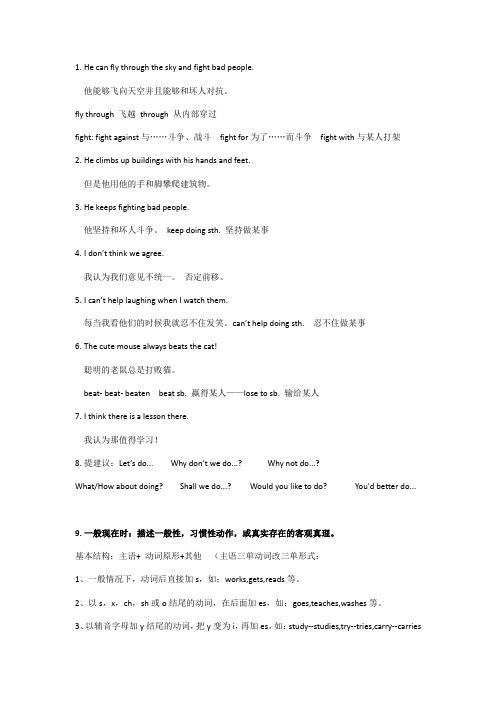
1.He can fly through the sky and fight bad people.他能够飞向天空并且能够和坏人对抗。
fly through 飞越through 从内部穿过fight: fight against与……斗争、战斗fight for为了……而斗争fight with与某人打架2.He climbs up buildings with his hands and feet.但是他用他的手和脚攀爬建筑物。
3.He keeps fighting bad people.他坚持和坏人斗争。
keep doing sth. 坚持做某事4.I don’t think we agree.我认为我们意见不统一。
否定前移。
5.I can’t help laughing when I watch them.每当我看他们的时候我就忍不住发笑。
can’t help doing sth. 忍不住做某事6.The cute mouse always beats the cat!聪明的老鼠总是打败猫。
beat- beat- beaten beat sb. 赢得某人——lose to sb. 输给某人7.I think there is a lesson there.我认为那值得学习!8.提建议:Let’s do... Why don’t we do...?Why not do...?What/How about doing?Shall we do...?Would you like to do?You'd better do...9.一般现在时:描述一般性,习惯性动作,或真实存在的客观真理。
基本结构:主语+ 动词原形+其他(主语三单动词改三单形式:1、一般情况下,动词后直接加s,如:works,gets,reads等。
2、以s,x,ch,sh或o结尾的动词,在后面加es,如:goes,teaches,washes等。
初中英语 外研版八年级下学期Module1-Module5 词汇专练(有答案)
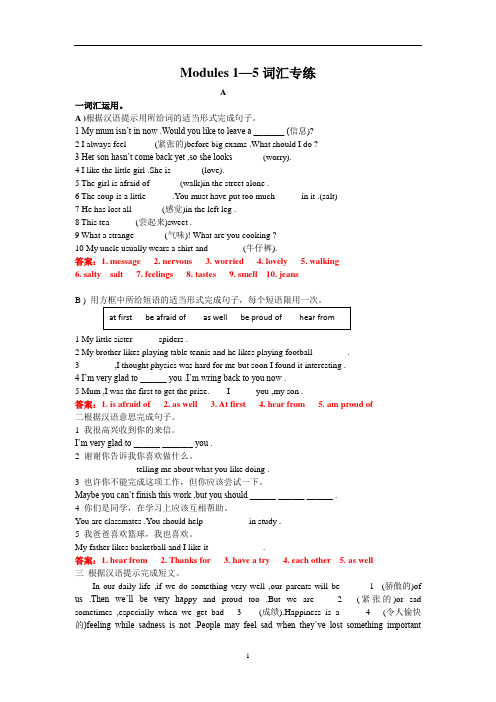
Modules 1—5词汇专练A一词汇运用。
A )根据汉语提示用所给词的适当形式完成句子。
1 My mum isn’t in now .Would you like to leave a _______ (信息)?2 I always feel ______(紧张的)before big exams .What should I do ?3 Her son hasn’t come back yet ,so she looks ______ (worry).4 I like the little girl .She is ______ (love).5 The girl is afraid of ______ (walk)in the street alone .6 The soup is a little _____ .You must have put too much _____ in it .(salt)7 He has lost all ______ (感觉)in the left leg .8 This tea _____ (尝起来)sweet .9 What a strange ______ (气味)! What are you cooking ?10 My uncle usually wears a shirt and _______ (牛仔裤).答案:1. message 2. nervous 3. worried 4. lovely 5. walking6. salty salt7. feelings8. tastes9. smell 10. jeansB )1 My little sister _____ spiders .2 My brother likes playing table tennis and he likes playing football _______ .3 _______ ,I thought physics was hard for me but soon I found it interesting .4 I’m very glad to ______ you .I’m wring back to you now .5 Mum ,I was the first to get the prize. I _____ you ,my son .答案:1. is afraid of 2. as well 3. At first 4. hear from 5. am proud of二根据汉语意思完成句子。
Module 5 Unit 1 知识点详解-外研版八年级下册英语
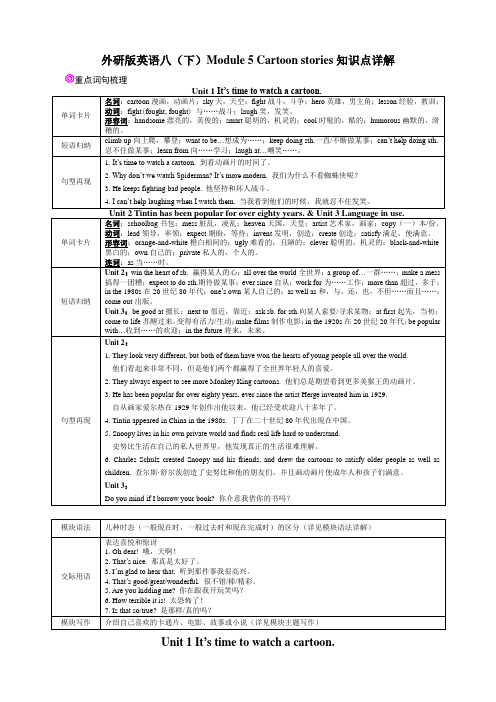
外研版英语八(下)Module 5 Cartoon stories知识点详解Unit 1 It’s time to watch a cartoon.★(A2).【知识点再现】handsome【知识点1】【辨析】handsome,beautiful,good-looking与pretty的用法辨析:①handsome是形容词,意为“英俊的”,主要指男子相貌等方面长得“英俊”。
如:Wang Ming is a handsome young man. 王明是一位英俊的年轻人。
②beautiful是形容词,意为“美丽的”,一般指女子的“美丽”,也可以用来指事物。
如:Lily is a beautiful girl. 莉莉是一个美丽的女孩。
③good-looking是形容词,意为“好看的”,主要用于人(男人、女人或小孩),一般不用于物。
如:Susan is good-looking. 苏珊长得很好看。
④pretty是形容词,意为“漂亮的”,常用于女性、小孩或事物,语气比beautiful弱,侧重“小巧玲珑”的“美”。
如:They have a pretty daughter. 他们有一个漂亮的女儿。
★(A3).【知识点再现】We’ve finished our homework. 我们已经完成了家庭作业。
【知识点2】finish (doing) sth. 意为“完成(做)某事”。
finish为及物动词。
后多跟名词(词组)或动名词形式作宾语。
如:When did you finish working yesterday? 你昨天什么时候结束工作的?Did you finish writing your homework? 你完成写家庭作业了吗?I have already finished my homework. 我已经完成我的作业了。
【拓展】后面可跟名词(词组)或动名词形式作宾语的词还有:practise, miss, mind, avoid, imagine, enjoy, keep, give up, look forward to等。
Module 1 Unit 2、Unit 3 知识点详解-外研版八年级下册英语
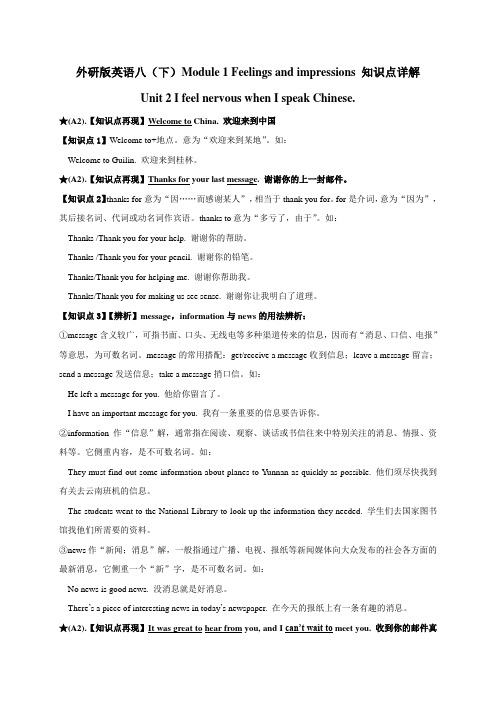
外研版英语八(下)Module 1 Feelings and impressions 知识点详解Unit 2 I feel nervous when I speak Chinese.★(A2).【知识点再现】Welcome to China. 欢迎来到中国【知识点1】Welcome to+地点。
意为“欢迎来到某地”。
如:Welcome to Guilin. 欢迎来到桂林。
★(A2).【知识点再现】Thanks for your last message. 谢谢你的上一封邮件。
【知识点2】thanks for意为“因……而感谢某人”,相当于thank you for。
for是介词,意为“因为”,其后接名词、代词或动名词作宾语。
thanks to意为“多亏了,由于”。
如:Thanks /Thank you for your help. 谢谢你的帮助。
Thanks /Thank you for your pencil. 谢谢你的铅笔。
Thanks/Thank you for helping me. 谢谢你帮助我。
Thanks/Thank you for making us see sense. 谢谢你让我明白了道理。
【知识点3】【辨析】message,information与news的用法辨析:①message含义较广,可指书面、口头、无线电等多种渠道传来的信息,因而有“消息、口信、电报”等意思,为可数名词。
message的常用搭配:get/receive a message收到信息;leave a message留言;send a message发送信息;take a message捎口信。
如:He left a message for you. 他给你留言了。
I have an important message for you. 我有一条重要的信息要告诉你。
②information作“信息”解,通常指在阅读、观察、谈话或书信往来中特别关注的消息、情报、资料等。
外研版英语八年级下册Module1模块知识点归纳

Module 1 Feelings and impression知识点归纳知识点归纳一、短语归纳1.a bit一点点一点点课本原句:P2 It smells too strong and it tastes a bit sour. a bit 相当于a little,都可以修饰adj或者adv的原级和比较级、以及不可数名词,但是a bit修饰不可数名词后面要加of。
例1:There is a bit of milk in the bottle.=There is a little milk in the bottle. 2. be done 做好了,完成了课本原句:P2 Well,my chocolate cookies are done now.Have a try. 例2:The work _______ _________ ________until tomorrow. 这工作要到明天才能完成。
能完成。
例3:—Is the kite ______now? —Yes, we can fly it this afternoon. A.do B. doing C. done 3.have a try 试试试试看,尝一尝例4:I have just made a cake. ______ ______ ______. 例5:I will have a try even though I may fail. 4.have a sweet tooth 爱吃甜食课本原句:P2 I have a sweet tooth,you know.Shall I get the sugar? Tooth牙齿其复数为teeth :大多数孩子喜欢吃甜食例6:大多数孩子喜欢吃甜食Most children have a sweet tooth. 4.in the middle 课本原句:They taste really sweet and they feel soft in the middle. 那张小桌子在中间。
外研版八年级下册英语Moudle1-Moudle5知识要点总结
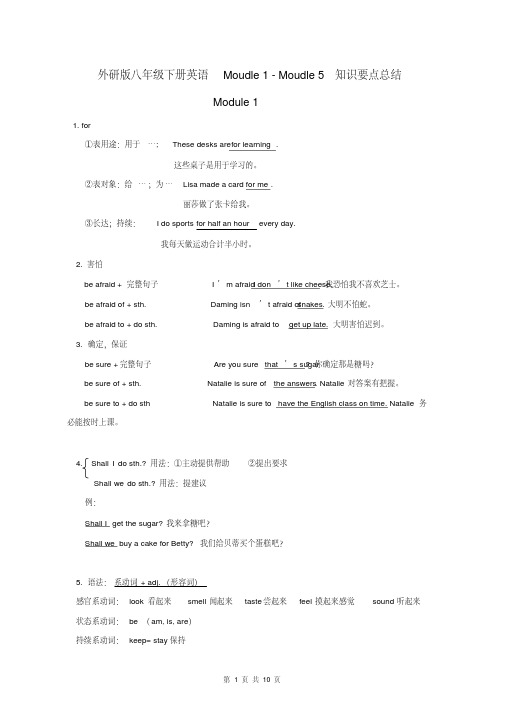
外研版八年级下册英语Moudle 1 - Moudle 5 知识要点总结Module 11. for①表用途:用于…; These desks are for learning.这些桌子是用于学习的。
②表对象:给…;为… Lisa made a card for me.丽莎做了张卡给我。
③长达;持续:I do sports for half an hour every day.我每天做运动合计半小时。
2. 害怕be afraid +完整句子I’m afraid I don’t like cheese.我恐怕我不喜欢芝士。
be afraid of + sth. Daming isn’t afraid of snakes. 大明不怕蛇。
be afraid to + do sth. Daming is afraid to get up late. 大明害怕迟到。
3. 确定,保证? 你确定那是糖吗?be sure +完整句子Are you sure that’s sugarbe sure of + sth. Natalie is sure of the answers. Natalie对答案有把握。
be sure to + do sth Natalie is sure to have the English class on time. Natalie务必能按时上课。
4. Shall I do sth.? 用法:①主动提供帮助②提出要求Shall we do sth.? 用法:提建议例:Shall I get the sugar? 我来拿糖吧?Shall we buy a cake for Betty? 我们给贝蒂买个蛋糕吧?5. 语法:系动词+ adj.(形容词)感官系动词:look看起来smell闻起来taste尝起来feel摸起来感觉sound听起来状态系动词:be (am, is, are)持续系动词:keep= stay保持变化系动词:become,get, grow, turn 变得普通实义动词+ adv.(副词)例:run fast, eat quickly, sleep well6. 注意: 感官动词的否定形式和疑问形式要借助动词do/ does。
- 1、下载文档前请自行甄别文档内容的完整性,平台不提供额外的编辑、内容补充、找答案等附加服务。
- 2、"仅部分预览"的文档,不可在线预览部分如存在完整性等问题,可反馈申请退款(可完整预览的文档不适用该条件!)。
- 3、如文档侵犯您的权益,请联系客服反馈,我们会尽快为您处理(人工客服工作时间:9:00-18:30)。
外研版英语八年级下册知识点Module 1 —5Module 1语法:系动词:一是(be: am ,is ,are ,been ,was ,were一), 觉得(feel),一好像(seem),一保持(keep) ,,起来(smell, sound ,look ,taste)后,跟形容词.三变化(turn, become, get )四知识点:1.wouldlike =want , would like to do sth=want to do sth . 想要做某事would like sb. to do sth .=wantsb. to do sth想要某人做某事would you like ...? 其后用some 不用any . 句子:Would you like to do sth .肯定回答:Yes ,please ./sure ,thanks ./Yes ,I ’d like to./Yes ,I ’d love to否定回答:No, thanks ./Sorry ,I ’m afraid I can ’t .2.try to do sth .尽力做某事;试图做某事;设法做某事,但不一定成功.否定式:try not to do sth.try doing sth .试着做某事,看看会发生什么情况. have a try试一试3.a bit 与alittle 1)两者修饰动词,形容词,副词或比较级,2)a little 可以直接修饰不可数名词,相当于a bit of4.have a try试试看, have a look 看一看have a headache头疼have a rest休息have a meeting开会have a good time玩得愉快have a fever发烧5.lots of =a lot of 很多,大量,常用于肯定句中.既可修饰可数相当于many , 又可修饰不可数,相当于much . a lot 相当于very much ,多与动词连用,修饰形容词,副词的比较级.6.提出建议:1)Let ’s do 让sth我. 们做吧. 2)How about /what about doing sth ?做..怎么样3)Why not d o sth ?为什么不? 4)Would you like to do 你愿?意做.吗?5)Shall we do 我们?做好吗? 6)You ’dbetter(not) do你..最好(不)做某事.7.Thanks for sth. =Thank youfor sth.因而感谢.后V+ing . Thanks to 幸亏,由于,归功于.8.leave a message留个口信, take/have a message for sb给. 某人带个口信.9.hear from sb.=get /receive aletter from sb 收.到的来信hear about /of得悉,听说Hear out 听完hear to 同意10.can ’t wait to do s迫t h 不. 及待做某事wait for 等候,后接等待的对象,名词或代词wait to do sth .等着做某事1.三到达:arrive at (小地方),arrive in ( 大地方),get to =reach注意:跟home,here ,there等副词时, 不加介词.12.quite 相当,很,相当于very,区别, quite a ../ quite an .而.very 只能放在 a /an后13.with 有,带有;和一起;使用等.反义词without14.lovely: 令人愉快的,可爱的修饰人或物 a lovely afternoon / girllively: 活泼的,生动的 a lively lesson:一堂生动的课16. 四个花费: take: It takes sb. some timeto do sth. /It took sb .some time to do sth .Spend : Sb. spend some time/ money on sthSb. spend some time/ money (in) doing sth.Pay: Sb. pay some money forsth.cost : sth cost sb .some money .17. 四个也:as well 肯定,句末,不用逗号too,肯定,句末,逗号可有可无.either:否定句末, also ,肯定句中,行前be 后.18. proud .adj. be proud of 为而感到骄傲be proud to do sth 做.某事很自豪.pride. n. take pride in 为.感到自豪; the pride o f的骄.傲.19. How do you feel about 对?感觉如何?与How do you like ?20. at first 起初,开始,常位于句首或句末,反义词.at last 最后,终于first of all , 首先,用作插入语,说明顺序,后接next ,then , at first ,指刚开始做某事的时候,暗示后来的情况有所改变.21. few /a few 修饰可数名词,little /a little 修饰不可数名词,有a 表示有,没有a 表示没有.22.way 的短语:in this way 用这种方式, in the right way 用正确的方法, the way of 做..的方式on the way to 在去的路上bythe way 顺便说一下.23.be afraid of 害怕,后接名词,代词或动名词be afraid todo sth .害怕做某事24.each other互相25.be nervous about对感到紧张26. 问外貌:What+do/does /did +主语+look like ? 问性格:What +be +主语+like ?27. be friendly to sb. 对某人友好- 28.be good at =do well in擅长,后跟doingsth .或名词。
29.shake hands with sb与. 某人握手30.be good for对有好处, 反义:be bad for .对..有害31.help sb. with sth .在某方面帮助某人, help sb dosth 帮.助某人做某事32.m ake a lot of noise =makemuch noise发出很多噪音书面表达写一篇文章介绍你的网友,内容包括:1. 来自于澳大利亚的悉尼;2. 年龄:15 岁;3. 外貌:很瘦;眼睛很大;头发长且卷曲;4. 性格:很友好;很外向;5. 爱好:读书、上网与朋友聊天。
注意:词数70 左右。
I have a net friend. She is from Sydney,Australia.The girl is fifteen years old. She is thin with two big eyes. She has long fairhair. She is friendly and outgoing. She always has a big smile on her face. Shelikes reading and chatting on the Internet with her friends. She said that readingmade her grow up as a person. I feel very happy when I chat with her. I like mynet friend very much. I hope I can go to Sydneyto see her one day.Module 2语法:现在完成时:表过去发生或已经完成的某一动作,对现在造成的影响和结果,或持续到现在的动作。
常用词语already, yet ,ever ,never, just ,before, for+ some time ,sinc,e1. 表示某人的经历以及过去发生的动作对现在造成的影响,或结果,常与recently, ever, never, already, yet ,just,before连用;2. 表示发生在过去并且一直持续到现在的动作或状态,常与for+ 时间段或since+时间点连用。
结构:have(has)+过去分词,动词的过去式及过去分词在末尾加ed 规则是:1.直接加ed ;2.以e 结尾的,加e ;3.以辅音字母加y 结尾的,变y 为i , 再加ed ;4.重读,末尾辅元辅,双写这个辅音字母,再加ed ;5,不规则变化知识点:1.enter 参加,加入;进入,相当于join 或go into2.maybe=perhaps大概,也许.放句首.3.win ,后接war,match ,game; beat打败,击败,后跟人. 打败某人,赢得比赛4.ever 用于疑问句时,其答语如果表示否定,用never 回答.5.before 以前.从过去起的若干时间以前, 距过去某时以前,常和完成时连用ago ,从现在起的若干时间以前跟今以前,常用于过去时态中6.go on a holiday .去度假,强调动作. be on aholiday也表示去度假,强调状态.7.afford 买得起,付得起,常与can ,could ,be able to连用.8.stop doing sth.停止做某事(正在做的事不做了.)不做.stop to do sth 停.下来(正在做的事)去做某事(另一件事)要做9.what a pity /That ’s多a遗pi憾ty啊. .10.think of 想起,起出,认为think about 思考,考虑两者区别:1)当表示”想起,想出”时,两者可以互换2)当thinkof 表示”认为”时, 不能用think about 3)当think about 表示”思考,研究”时,不能用think of .1.thanks for = thank youfor+名词或动词ing 因而感谢你Thank you for helping me.13.invite sb. to do sth.邀请某人做某事invite sb. to someplace邀请某人去某地.14.at the moment此刻,现在,常与一般现在时或现在进行时连用.at that moment在那时,常与一般过去时连用.15.one of +形容词最高级+名词复数,最的之一,动词用三单形式.16.send sth .to do sth =sendsb. st把h某物寄给某人.17.5. the + 姓氏s : 一家人,夫妇, 其作主语时,谓语动词用复数形式。
